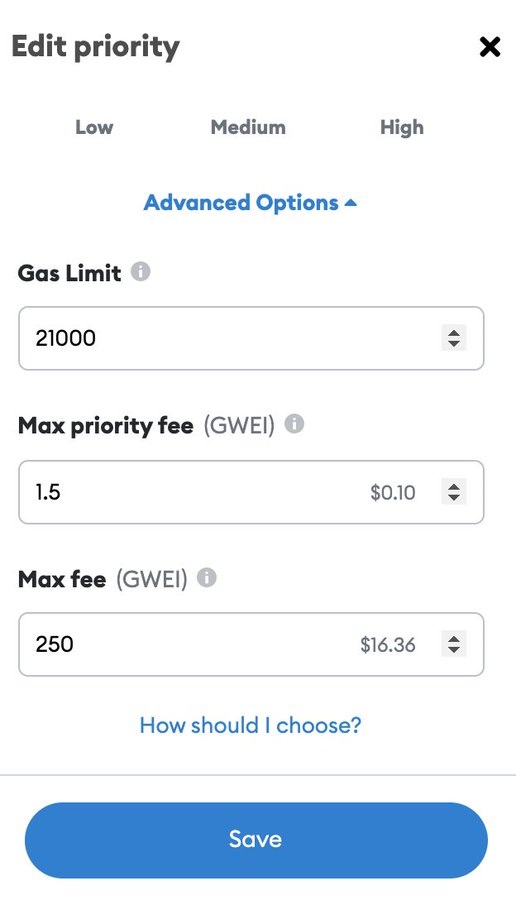Ethereum Gas Fee?
Ethereum changed how it calculates and handles 𝐠𝐚𝐬 𝐟𝐞𝐞𝐬 with 𝐄𝐈𝐏-𝟏𝟓𝟓𝟗. It makes understanding (and explaining) how gas works on Ethereum even more complex
But you should understand it. So here we go…
First, let’s understand how gas USED to work. To understand gas, you needed to know three things:
1) 𝐆𝐚𝐬 𝐜𝐨𝐬𝐭 — the amount of computation and storage used by a transaction, measured in units of ”gas“ Think of this as the number of gallons of gas you need to fuel your car for a road trip…except in our case, this is the gas required to fuel the Ethereum transaction 🙂
2) 𝐆𝐚𝐬 𝐩𝐫𝐢𝐜𝐞 — the cost per unit of gas that the sender is willing to pay Think of this as the price per gallon of gas you are willing to pay
𝐍𝐨𝐭𝐞: Gas prices are denoted in 𝐠𝐰𝐞𝐢, which is equal to 0.000000001 ETH (10^9 ETH) Instead of saying that your gas costs 0.000000001 ether, you can say your gas costs 1 gwei
3) 𝐆𝐚𝐬 𝐥𝐢𝐦𝐢𝐭 — the max amount of gas a sender is willing to use for that transaction (i.e. upper bound for gas cost) Think of this as the maximum number of gallons of gas you are willing to buy to justify the road trip. If it goes over, you cancel the road trip…
Or in the case of Ethereum, the transaction is reverted.
Therefore, your “𝐓𝐫𝐚𝐧𝐬𝐚𝐜𝐭𝐢𝐨𝐧 𝐟𝐞𝐞” was calculated as:
𝐆𝐚𝐬 𝐜𝐨𝐬𝐭 𝐱 𝐆𝐚𝐬 𝐩𝐫𝐢𝐜𝐞
Let’s say Alice wants to pay Bob 3 ETH. A simple ETH transfer costs 21,000 units of gas. Let’s assume the current gas price is 300 gwei (gas price changes based on the demand on the network)
Transaction fee = 21,000 gas x 300 gwei = 6,300,000 gwei or 0.0063 ETH
This entire transaction fee would go to miners for including your transaction in a block.
But ever since the London hard fork and implementation of EIP-1559 in early August 2021, there is a 𝐧𝐞𝐰 𝐦𝐞𝐭𝐡𝐨𝐝 for calculating transaction fees Transactions moved from a blind auction system to a hybrid system with “base fees” and “tips”
Instead of keeping track of the 𝐠𝐚𝐬 𝐩𝐫𝐢𝐜𝐞, we now have to keep track of 3 different variables:
𝐁𝐚𝐬𝐞 𝐅𝐞𝐞 — as the name sounds, this is the base fee per unit of gas that is used in that transaction This fee is determined by the Ethereum network itself This “fee” is subsequently 𝐛𝐮𝐫𝐧𝐞𝐝
𝐌𝐚𝐱 𝐏𝐫𝐢𝐨𝐫𝐢𝐭𝐲 𝐅𝐞𝐞 — an optional tip that is paid directly to miners
(NOTE: The tip would be calculated as Max priority fee x Gas cost)
𝐌𝐚𝐱 𝐅𝐞𝐞 𝐏𝐞𝐫 𝐆𝐚𝐬 — the absolute maximum you are willing to pay per unit of gas to get your transaction included in a block (this is similar to “Gas price”, except now it includes both the Base Fee + Max Priority fee)
𝐆𝐚𝐬 𝐥𝐢𝐦𝐢𝐭 stays the same, which is the max units of gas a sender is willing to use for that transaction 𝐆𝐚𝐬 𝐜𝐨𝐬𝐭 also stays the same, which is the amount of gas used by the transaction
Therefore.. 𝐓𝐫𝐚𝐧𝐬𝐚𝐜𝐭𝐢𝐨𝐧 𝐟𝐞𝐞 = (Base Fee + Max Priority fee) x Gas cost
Let’s look at a little closer at Base fee, Max priority fee, and Max fee per gas
The base fee that is set by the Ethereum network aims to have 50% full blocks. Depending on how full the last block was, the Base Fee is automatically increased or decreased
If the last block was…
𝟓𝟎% 𝐟𝐮𝐥𝐥 → Base Fee will remain unchanged
𝟏𝟎𝟎% 𝐟𝐮𝐥𝐥 → Base Fee will increase by the maximum 12.5% for the next block
𝟎% 𝐟𝐮𝐥𝐥 → Base fee will decrease by a maximum of 12.5% for the next block
𝐁𝐞𝐭𝐰𝐞𝐞𝐧 𝟓𝟏% – 𝟗𝟗% 𝐟𝐮𝐥𝐥 → Base Fee will increase by less than 12.5%
𝐁𝐞𝐭𝐰𝐞𝐞𝐧 𝟎% – 𝟓𝟎% 𝐟𝐮𝐥𝐥 → Base Fee will decrease by less than 12.5%
By automatically setting the base fee based on the current block fullness, the goal is to help prevent sudden spikes in transaction fees
Moreover, all of the transaction fees collected from base fees is 𝐁𝐔𝐑𝐍𝐄𝐃 (i.e. ETH supply is reduced)
The Max Priority Fee (i.e. “miner tip”) is optional fee that is paid directly to miners in order to incentivize them to include your transaction in a block.
While it is optional, it is unlikely that your transaction will be included unless you set the max priority fee to some minimum
At the moment, Metamask defaults max priority fee to 𝟏.𝟓 𝐠𝐰𝐞𝐢 for a simple value transfer at “Medium” priority

If you want miners to prioritize your transactions, you probably want to increase your tip.
Now, there is one subtly to understand here:
The Max Priority Fee is the 𝐦𝐚𝐱𝐢𝐦𝐮𝐦 𝐭𝐢𝐩 you are willing to pay a miner
However, if the Base Fee + Max Priority Fee exceeds the Max Fee per Gas, the 𝐌𝐚𝐱 𝐏𝐫𝐢𝐨𝐫𝐢𝐭𝐲 𝐅𝐞𝐞 𝐰𝐢𝐥𝐥 𝐛𝐞 𝐫𝐞𝐝𝐮𝐜𝐞𝐝 so that your total fee is still below the Max fee per Gas…
This means the actual tip you end up paying to the miner might be smaller than your Max Priority Fee (e.g. if the Base Fee increases a lot by the time your transaction is included)
This is why it is currently considered best practice to set a Max Fee per gas that 𝐚𝐧𝐭𝐢𝐜𝐢𝐩𝐚𝐭𝐞𝐬 𝐬𝐮𝐜𝐡 𝐚𝐧 𝐢𝐧𝐜𝐫𝐞𝐚𝐬𝐞 𝐢𝐧 𝐭𝐡𝐞 𝐁𝐚𝐬𝐞 𝐅𝐞𝐞 so that your transaction is attractive to miners even if the Base fee goes up
IF you are still paying attention, kudos to you 😉


















